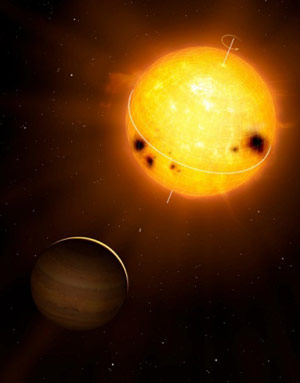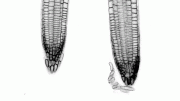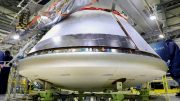
An artistic rendering of HD 52265 and its orbiting Jupiter-like planet. Asteroseismology shows that the solar-like star, HD52265, rotates at 2.3 times faster than the Sun with an axis of rotation inclined at 30 degrees to the line-of-sight. A 1.85 Jupiter mass planet, HD52265b, orbits the star. Credit: Courtesy of MPI for Solar System Research/Mark A. Garlick.
Using asteroseismic data obtained by the CoRoT space telescope, a team of scientists was able to measure the internal rotation of a Sun-like star and determine the inclination of its rotation axis.
A team of researchers has devised a way to measure the internal properties of stars—a method that offers more accurate assessments of their orbiting planets.
The research, which appears in Proceedings of the National Academy of Sciences, was conducted by a multi-national team of scientists, including physicists at New York University, Princeton University, and the Max Planck Institute for Solar System Research.
The researchers examined HD 52265—a star approximately 92 light years away and nearly 20 percent more massive than our Sun. More than a decade ago, scientists identified an exoplanet—a planet outside our Solar System—in the star’s orbit. HD 52265, then, served as an ideal model for both measuring stars’ properties and how such properties can shed light on planetary systems.
Previously, scientists inferred stars’ properties, such as radius, mass, and age, by considering observations of their brightness and color. Often these stars’ properties were not known to sufficient accuracy to further characterize the nearby planets.
In the PNAS study, the scientists adopted a new approach to characterize star-planet systems: asteroseismology, which identifies the internal properties of stars by measuring their surface oscillations. Some have compared this approach to seismologists’ use of earthquake oscillations to examine the earth’s interior.
Here, they were able to make several assessments of the star’s traits, including its mass, radius, age, and—for the first time— internal rotation. They used the COROT space telescope, part of a space mission led by the French Space Agency (CNES) in conjunction with the European Space Agency (ESA), to detect tiny fluctuations in the intensity of starlight caused by starquakes. The researchers confirmed the validity of the seismic results by comparing them with independent measurements of related phenomena. These included the motion of dark spots on the star’s surface and the star’s spectroscopic rotational velocity.
Unlike other methods, the technique of asteroseismology returns both the rotation period of the star and the inclination of the rotation axis to the line of sight.
The scientists could then use these findings to make a more definitive determination of an orbiting exoplanet. While it had previously been identified as an exoplanet by other scientists, some raised doubts about this conclusion, positing that it could actually be a brown dwarf—an object too small to be a star and too large to be a planet.
But, armed with the precise calculations yielded by asteroseismology, the researchers on the PNAS study were able to enhance the certainty of the earlier conclusion. Specifically, given the inclination of the rotation axis of HD 52265 and the minimum mass of the nearby exoplanet, the researchers could infer the true mass of the latter—which was calculated to be roughly twice that of our planet Jupiter and therefore too small to be a brown dwarf.
The study’s authors included: Katepalli Sreenivasan, president of Polytechnic Institute of NYU and dean of engineering at NYU; Shravan Hanasoge, an associate research scholar in geosciences at Princeton University and a visiting scholar at NYU’s Courant Institute of Mathematical Sciences; and Laurent Gizon, director of the Max Planck Institute for Solar System Research and a professor at the University of Goettingen in Germany.
Reference: “Seismic constraints on rotation of Sun-like star and mass of exoplanet” by Laurent Gizon, Jérome Ballot, Eric Michel, Thorsten Stahn, Gérard Vauclair, Hans Bruntt, Pierre-Olivier Quirion, Othman Benomar, Sylvie Vauclair, Thierry Appourchaux, Michel Auvergne, Annie Baglin, Caroline Barban, Fréderic Baudin, Michaël Bazot, Tiago Campante, Claude Catala, William Chaplin, Orlagh Creevey, Sébastien Deheuvels, Noël Dolez, Yvonne Elsworth, Rafael García, Patrick Gaulme, Stéphane Mathis, Savita Mathur, Benoît Mosser, Clara Régulo, Ian Roxburgh, David Salabert, Réza Samadi, Kumiko Sato, Graham Verner, Shravan Hanasoge and Katepalli R. Sreenivasan, 29 July 2013, Proceedings of the National Academy of Sciences.
DOI: 10.1073/pnas.1303291110









Be the first to comment on "Scientists Determine the Interior Rotation of a Sun-Like Star"